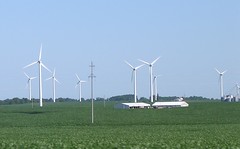 Growing up, we had a windmill on the farm. It wasn't like this. It was a metal contraption that creaked and groaned when it worked. These, seen on my way to Iowa Thursday, are solely for the generation of power. Our farm windmill did that, but not with the efficiency that these do.
Growing up, we had a windmill on the farm. It wasn't like this. It was a metal contraption that creaked and groaned when it worked. These, seen on my way to Iowa Thursday, are solely for the generation of power. Our farm windmill did that, but not with the efficiency that these do. But then, these don't have much character. Sorry, green fans, they just don't.
See on a farm, you have to be somewhat self-sufficient. Our windmill, with four legs, a flower fan, a rudder that spun the fan into the wind and a gear thingee at the bottom, was designed to do a couple of tasks. Some farmers had their windmill hooked up to a pulley system that would generate power which was stored in the shed in batteries. At any season, these batteries could be recharged to provide just enough power to keep the milk house cool or the fridge cold or the auger on the coal furnace going in the winter so the furnace would keep going and you didn't have to wake up at 2 a.m. to shovel coal.
The other thing the windmill did, and this is what ours did, was pump water.
Our windmill powered a pump that brought water from the well to the cistern. You city dwellers probably don't know what a cistern is. Ours was about 20 feet in diameter, poured concrete with a slightly rounded bottom. It looked like half a capsule of medicine. On the top of the cistern was a hand pump, cast iron. The cistern was also attached to a pump that pumped water into the house. The original house did not have running water. The porch, back entry and bathroom were all added in the 1950's.
I want to say every 2-3 weeks, dad would let the windmill fill the cistern. He, or mom, would go to the windmill and let the blades spin. There was a wooden level on one of the legs. It was held down by wires. You removed the wires and pushed the lever up and that allowed the blades to spin into the wind. It was a great honor to be finally tall enough to reach the lever because that meant you were allowed to go turn on the windmill.
The windmill would run for several hours and then be shut down. The head spun freely and the rudder on the back side of it kept it firmly facing the wind. You didn't want it spinning freely all the time because the parts would wear out and it was, in the late 1960's, getting hard to find people to fix these. I remember many a time dad would let the blades work in a summer thunderstorm, only to have to run outside in a driving rain to shut down the windmill so something wouldn't break. It was noisy when working but that was a small price to pay for knowing it was doing its job.
I saw the inside of the cistern only once. We had a prolonged drought when I was 6, I believe. Water tables on farms dropped and wind powered pumps could not reach water. I remember the fire department brought out their pumper truck filled with water. They started at each house on the road and either topped off or filled the cistern. It took 3 men to take the cast iron pump off and shove the concrete top off to open up the cistern for the water.
It wasn't completely dry; I think about 2 or 3 inches of dirty, smelly water was in the bottom. They pumped that out and then hauled out some gunk with buckets. The cistern was flushed clean with the fire hose and then fresh water pumped back in. I'm thinking there was a moratorium on bathing and I believe mom took some clothes to my grandfather's in town to wash. Grandpa had a wringer washer, which, in and of itself, is a blog post for another day.
I don't remember how long before sufficient rains came to refill the water table. It didn't mean that much to me then.
I look at these tall white, almost silent energy efficient machines and know that they are doing their part to contribute to green energy. But, I have to tell you, I miss that noise from a metal, four-legged wind machine.
Beverage: White zinfandel
Deb
P.S. Uncle Walter, rest in peace. I still think Epcot made a huge, huge mistake in replacing your voice with Jeremy Irons.
No comments:
Post a Comment